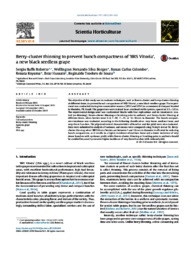Berry-cluster thinning to prevent bunch compactness of 'BRS Vitoria', a new black seedless grape.
Berry-cluster thinning to prevent bunch compactness of 'BRS Vitoria', a new black seedless grape.
Autoria: ROBERTO, S. R.; BORGES, W. F. S.; COLOMBO, R. C.; KOYAMA, R.; HUSSAIN, I.; SOUZA, R. T. de
Resumo: The objective of this study was to evaluate techniques, such as flower-cluster and berry-cluster thinning at different times, to prevent bunch compactness of ?BRS Vitoria?, a new black seedless grape. The experiment was conducted during two consecutive seasons (2013 and 2014) in a commercial vineyard located in Marialva, PR, Brazil. The grapevines were trained in an overhead trellis system, spaced at 2.5 × 5.0 m. The experimental design used was randomized blocks with four replications and six treatments: control (no thinning); flower-cluster thinning or brushing prior to anthesis; and berry-cluster thinning at different times, when berries were 3?6, 7?10, 11?15, or 16?18 mm in diameter. The bunch compactness incidence was evaluated according to the following classification: very loose, medium loose, and very dense bunches. The physicochemical characteristics of bunches and the yield were also evaluated. Data were submitted to analysis of variance, and means were compared using Tukey?s test at 5%. Berrycluster thinning when ?BRS Vitoria? berries are between 7 and 18 mm in diameter is efficient for reducing bunch compactness, as it results in a higher incidence of medium loose and a lower incidence of very dense bunches with optimum yield, while flower-cluster thinning or brushing prior to anthesis should be avoided because it promotes higher incidence of very loose bunches with reduced yield.
Ano de publicação: 2015
Tipo de publicação: Artigo de periódico
Unidade: Embrapa Uva e Vinho
Palavras-chave: Apirenic grape, Berry-cluster thinning, Cultural practices, Vine, Vitis spp
Observações
1 - Por padrão são exibidas publicações dos últimos 20 anos. Para encontrar publicações mais antigas, configure o filtro ano de publicação, colocando o ano a partir do qual você deseja encontrar publicações. O filtro está na coluna da esquerda na busca acima.
2 - Para ler algumas publicações da Embrapa (apenas as que estão em formato ePub), é necessário ter, no celular ou computador, um desses softwares gratuitos. Sistemas Android: Google Play Livros; IOS: iBooks; Windows e Linux: software Calibre.
Acesse outras publicações
Acesse a Base de Dados da Pesquisa Agropecuária (BDPA) para consultar o acervo completo das bibliotecas da Embrapa.

